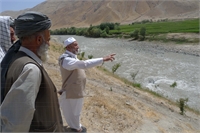
08 Jul Water Institutions Put to the Test in the Panj-Amu River Basin
Just a few years after the unprecedented dry spell of 2008, drought has struck again in northeastern Afghanistan. With rainfed areas severely affected, irrigated areas of “the grain basket†of Afghanistan become an ever more critical resource for local livelihoods and the country’s food security. In this context, a recurrent challenge for water institutions is the issue of how to share water among canals that flow from rivers crossing Takhar, Baghlan and Kunduz Provinces.
Since 2004, important efforts have been invested at a policy level to pass a new Water Law, develop regulations and set-up new organisational structures at the river-basin level. However, international experience shows that practices on the ground rarely evolve as policymakers envision. The 2011 drought is a critical period which has put local water management institutions to the test. It is thus an important time to study their performance and limitations. As AREU’s EC-funded research team explores responses to the drought in terms of water allocation along river basins, we progressively discover the complexity and the multiples challenges at stake.
The challenge of securing water rights
In the Lower-Kunduz sub-basin for instance, the traditional water allocation of system of abandaz (unsecured water rights defined in an informal and ad hoc way, for a limited period of time and based on upstream water users’ good will) is showing its limits, particularly for downstream users. While 40 years ago it was conventional for upstream users to release water for three to five days at different moments of the irrigation season, this has become much harder to implement in the face of increasing water management challenges. This is largely owing to the increasing water demand that has developed over the past decades: rice intensification, increasing irrigation intensity and pressure on the land, and development of new productive forms of water use along canals, such as micro-hydropower. As a result, traditional water allocation is increasingly unacceptable to downstream users, who are demanding more secured forms of water rights (akaba), while upstream farmers tend to resist change. Being able to facilitate a transition to a more socially acceptable definition and regulation of water rights in times of drought is going to be an important challenge for local water management institutions as they evolve.
Resistance to imported “good water governance†principles
The Taloqan sub-basin provides an example of how new water governance models can be resisted. The 2009 Water Law calls for a decentralised decision-making structure, taking the river basin as the unit of water management. On paper, water users are given a central position in taking decisions, while the government is expected to limit itself to a technical advisory role. But two years after the passage of the law, responses to the drought show that in practice, there is a clear resistance to the ideas encompassed in this model—especially on the part of the state. As an illustration, a top-down presidential decree has been designed by a technical commission in Kabul and then enforced as an attempt to resolve the intensifying upstream/downstream problems of water allocation between Takhar and Kunduz Provinces. Despite official protests in upstream areas, the protection of “national interests†and the “lack of readiness and capacity†of water users to solve water allocation problems at sub-basin level have been presented in Kabul as key arguments to justify the “temporary†re-appropriation of decision making by high-level central authorities. This raises significant questions about the sincerity of high-level power brokers vis-à -vis the imported concepts of good governance as defined in the Water Law.
Afghanistan is currently in the thick of “institutional bricolage,†where actors are borrowing from old and existing practices when creating new institutions—in this case, within the framework of a new water sector reform. In particular, power relations—the ability of different actors to mobilise various means to achieve their goals—are influencing how these institutions are shaped. Since the success of new river basin institutions is highly dependent on how they build on existing ones, it is vital to describe, analyse and reflect on the interface between local institutions on the one hand, and those suggested by policy models on the other.

